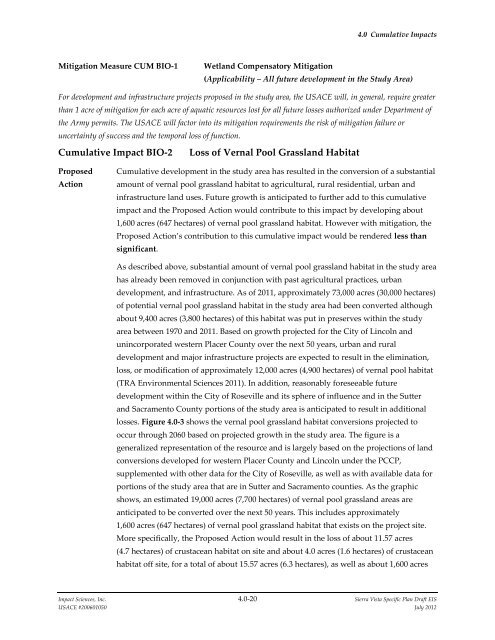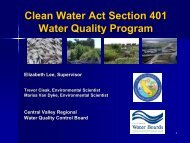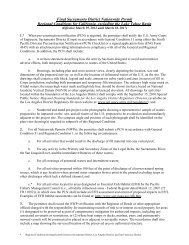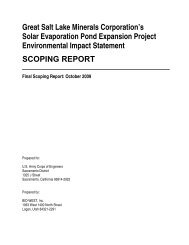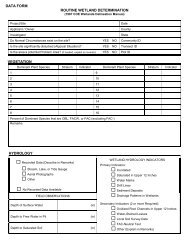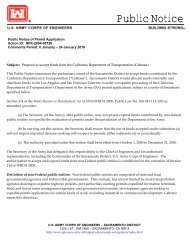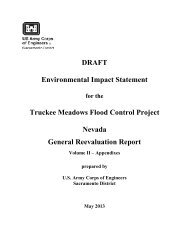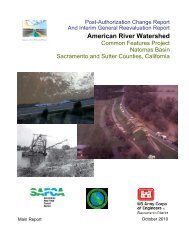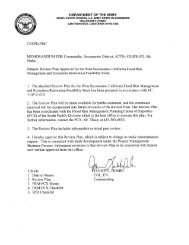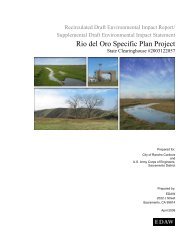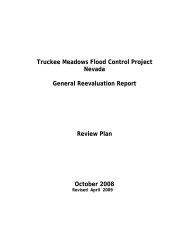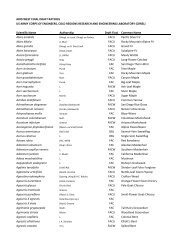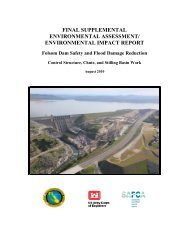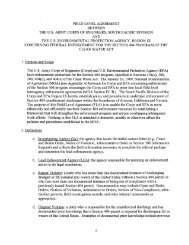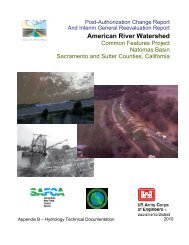4.0 CUMULATIVE IMPACTS - Sacramento District - U.S. Army
4.0 CUMULATIVE IMPACTS - Sacramento District - U.S. Army
4.0 CUMULATIVE IMPACTS - Sacramento District - U.S. Army
Create successful ePaper yourself
Turn your PDF publications into a flip-book with our unique Google optimized e-Paper software.
<strong>4.0</strong> Cumulative Impacts<br />
Mitigation Measure CUM BIO-1<br />
Wetland Compensatory Mitigation<br />
(Applicability – All future development in the Study Area)<br />
For development and infrastructure projects proposed in the study area, the USACE will, in general, require greater<br />
than 1 acre of mitigation for each acre of aquatic resources lost for all future losses authorized under Department of<br />
the <strong>Army</strong> permits. The USACE will factor into its mitigation requirements the risk of mitigation failure or<br />
uncertainty of success and the temporal loss of function.<br />
Cumulative Impact BIO-2 Loss of Vernal Pool Grassland Habitat<br />
Proposed<br />
Action<br />
Cumulative development in the study area has resulted in the conversion of a substantial<br />
amount of vernal pool grassland habitat to agricultural, rural residential, urban and<br />
infrastructure land uses. Future growth is anticipated to further add to this cumulative<br />
impact and the Proposed Action would contribute to this impact by developing about<br />
1,600 acres (647 hectares) of vernal pool grassland habitat. However with mitigation, the<br />
Proposed Action’s contribution to this cumulative impact would be rendered less than<br />
significant.<br />
As described above, substantial amount of vernal pool grassland habitat in the study area<br />
has already been removed in conjunction with past agricultural practices, urban<br />
development, and infrastructure. As of 2011, approximately 73,000 acres (30,000 hectares)<br />
of potential vernal pool grassland habitat in the study area had been converted although<br />
about 9,400 acres (3,800 hectares) of this habitat was put in preserves within the study<br />
area between 1970 and 2011. Based on growth projected for the City of Lincoln and<br />
unincorporated western Placer County over the next 50 years, urban and rural<br />
development and major infrastructure projects are expected to result in the elimination,<br />
loss, or modification of approximately 12,000 acres (4,900 hectares) of vernal pool habitat<br />
(TRA Environmental Sciences 2011). In addition, reasonably foreseeable future<br />
development within the City of Roseville and its sphere of influence and in the Sutter<br />
and <strong>Sacramento</strong> County portions of the study area is anticipated to result in additional<br />
losses. Figure <strong>4.0</strong>-3 shows the vernal pool grassland habitat conversions projected to<br />
occur through 2060 based on projected growth in the study area. The figure is a<br />
generalized representation of the resource and is largely based on the projections of land<br />
conversions developed for western Placer County and Lincoln under the PCCP,<br />
supplemented with other data for the City of Roseville, as well as with available data for<br />
portions of the study area that are in Sutter and <strong>Sacramento</strong> counties. As the graphic<br />
shows, an estimated 19,000 acres (7,700 hectares) of vernal pool grassland areas are<br />
anticipated to be converted over the next 50 years. This includes approximately<br />
1,600 acres (647 hectares) of vernal pool grassland habitat that exists on the project site.<br />
More specifically, the Proposed Action would result in the loss of about 11.57 acres<br />
(4.7 hectares) of crustacean habitat on site and about <strong>4.0</strong> acres (1.6 hectares) of crustacean<br />
habitat off site, for a total of about 15.57 acres (6.3 hectares), as well as about 1,600 acres<br />
Impact Sciences, Inc. <strong>4.0</strong>-20 Sierra Vista Specific Plan Draft EIS<br />
USACE #200601050 July 2012


